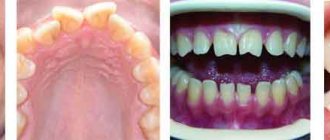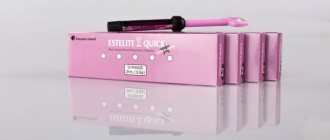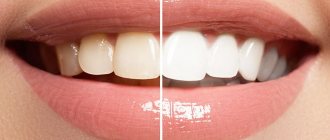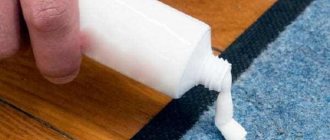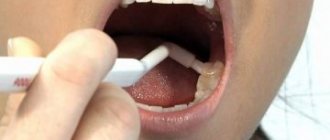1069
Among the various methods of modern dentistry used to solve problems with dentition defects, the installation of microprostheses rightfully deserves the attention of patients. The products help restore the functionality and aesthetics of the dentofacial apparatus.
A wide selection of microprostheses of domestic and foreign production allows you to restore damaged or missing teeth, in accordance with preferences, wishes, personal experience, and financial capabilities.
General overview
The microprosthetics technique is a convenient, effective way to hide defects and restore chewing functions in the absence of several units in the dentition. The goal of the method is to restore elements of the dentition with minimal damage to the hard tissues of the teeth.
The modern method of aesthetic dentistry is ideal for patients who have a negative attitude towards the preparation procedure that is necessarily carried out during classical prosthetics.
The list of materials used in the manufacture of orthopedic devices to restore the shape, color shade of partially damaged teeth or their complete loss includes:
- metal ceramics , which ensures the aesthetics and durability of products;
- nylon , the distinctive characteristics of which include hypoallergenicity and flexibility;
- porcelain and zirconium dioxide , which provides the opportunity to provide excellent aesthetics and strength of orthopedic structures;
- metal alloys based on Pd (Palladium), Au (gold) , combining strength, durability, and ductility;
- composite materials , with the help of which it is possible to restore fragments in hard-to-reach places.
When are removable microprostheses placed?
- Constantly worn in the absence of one or more teeth in order to avoid deformation of the dentition and to normalize chewing and digestion;
- As a temporary measure in the period before preparing for dental implantation (for example, when the hole is healing after tooth extraction);
- Wearing a microprosthesis if there are contraindications for the installation of permanent structures (for example, if it is impossible to carry out implantation or unwillingness to install bridges).
Indications and contraindications
Microprosthetics are indicated in a number of cases. These include:
- increased abrasion of enamel, which leads to a decrease in the protection of teeth from the destructive effects of aggressive environments and mechanical stress during chewing food;
- severe destruction of the supragingival part of the tooth, resulting from the lack of timely treatment of caries, demineralization of enamel, lack of calcium in the body of patients;
- absence of one or more elements;
- presence of chips, scratches, cracks;
- excessive mobility of the bone organs of the oral cavity;
- darkening of the enamel due to previous diseases;
- the desire to acquire an attractive smile, improve the shape and color of the enamel.
Timely seeking help from a dentist allows you to prevent severe destruction of dentition units and eliminate the need for classical prosthetics associated with depulpation of supporting elements.
The installation of orthopedic systems to replace completely destroyed fragments and restore their shape and color is not recommended:
- with an extended carious process;
- in case of inability to carry out high-quality hygiene procedures;
- inability to ensure dry surfaces of teeth requiring microprosthetics.
When cavities of small depth are identified, dentists recommend filling them.
Contraindications to microprosthetics
- poor oral hygiene;
- bruxism;
- multiple caries, damage to a large number of teeth;
- shallow cavity depth (for inlays);
- inability to provide conditions for prosthetics - absolute dryness of the tooth surface or cavity.
The need to use a particular method of microprosthetics is determined by the doctor individually, taking into account the characteristics of the dental system, the condition of the oral cavity, and the wishes of the patient.
Kinds
Orthodontic dentistry offers a wide selection of microprostheses for hiding and eliminating defects of bone organs in the oral cavity. Let's look at popular designs in more detail.
Adhesive bridges
It is planned to install fiberglass bridge systems to replace 1-2 elements.
Beams with prostheses are attached to the supporting units . The designs allow installation without turning the supporting elements.
Formed artificial teeth from light-polymerizing material are attractive due to their low cost.
Veneers and Lumineers
The products are overlays in the form of thin plates made of ceramics or composite materials. Their thickness varies from 0.2 mm to 1.5 mm. Attached to the outer surface of the tooth.
The use of ceramic and composite onlays involves minimal processing of bone organs and provides reliable protection from destruction.
Very thin layers are called lumineers. They are installed without grinding and allow you to create the charming smile that many Hollywood stars demonstrate.
Ceramic veneers are used to restore teeth, eliminate chips, unsightly shapes, and problems with occlusion. Composite overlays provide the opportunity to get rid of single defects in the form of cracks and stains on the enamel.
Tabs
The products are designed to restore severely damaged fragments, the chewing surface, as well as correct the shape and color.
They can be made from ceramics and cermets, composite materials, gold, alloys of silver with palladium, chromium with cobalt.
Pins
Microprosthetics using pins is intended to restore the supragingival part of a tooth destroyed under the influence of negative external factors.
Grinding of adjacent dentition units is not required. An artificial tooth crown is formed on the basis of a pin installed in its root part .
Butterflies
The use of nylon butterfly systems is recommended for the restoration of lost elements before the installation of fixed dentures.
The design has the shape of natural organs with special hooks in the form of wings. With their help, butterflies are attached to adjacent units without preliminary turning them.
CBW
CBW systems provide the opportunity to perform microprosthetics using a crownless bridge method.
They have proven themselves to be excellent in the restoration of anterior teeth and their analogues that perform a chewing function.
Features of the production of Cerec veneers and the material used for production.
Come here to find out what designs are used to relieve patients from completely edentulous teeth.
This address https://www.vash-dentist.ru/protezirovanie/semnyie-p/balochnyiy-na-implantatah.html provides detailed information about the advantages and disadvantages of beam dentures on implants.
Installation steps
Fixation of microprostheses involves performing certain stages. Their list includes:
- treatment of decaying teeth, elimination of carious lesions;
- installation of temporary filling materials in the formed cavities;
- taking impressions;
- production of microprostheses in laboratory conditions;
- installation of an orthopedic structure;
- providing recommendations for the care of microprostheses.
Installation of veneers and lumineers
Restoring teeth using veneers begins with treating pathologies of the elements, choosing the color and shape of the veneer. They are made in a laboratory after the impression is taken.
To prepare the tooth surface for their installation, grinding is performed to a depth corresponding to the thickness of the orthopedic device.
During the production of the veneer, a temporary structure is used to protect the enamel.
After making the onlay in the dentist’s office, it is tried on and assessed for accuracy of fit and compliance with the chosen shape and color. The veneer is then attached to the enamel using an adhesive.
Subsequent polishing of the surface of the lining makes it possible to hide the fixing seams. When installing lumineers, the stage of grinding down tooth enamel is eliminated.
After hygienic professional cleaning, the thinnest pads are installed in place. The adhesive composition ensures their reliable fixation to the tooth surface.
Creation of an adhesive prosthesis
Adhesive prostheses allow you to restore no more than 2 units and are installed within three hours.
The main element of fastening structures are wire or fiberglass beams, which are installed on the supporting teeth.
On them, the dentist forms future crowns from the composite. The absence of the need to manufacture metal bases makes it possible to reduce the time required for microprosthetics.
To fix adhesive bridges, special dental glue is used.
Installing a tab
Microprosthetics based on inlays are carried out in several stages. After radiography and treatment of oral pathologies, impressions are made. They are sent to the laboratory.
While the orthopedic device is being manufactured, a temporary inlay is placed in the patient's mouth.
After receiving the microprosthesis and removing the temporary device, the permanent structure is fixed under local anesthesia.
The use of cement or adhesive compositions ensures reliable adhesion to the hard tissues of the tooth. The sanding procedure completes the inlay installation process.
From the video, learn about the purpose and installation of a ceramic inlay.
Pins
Dental pins refer to orthopedic devices that look like rods and are installed in root canals.
The outer part is intended for restoring a dental crown. The reliability of the installation is checked the next day.
After completion of the rehabilitation period, the prosthesis is installed on the pin, first on a temporary and then on a permanent basis.
CBW dentures
Installation of CBW systems involves high-quality fastening of titanium or zirconium dioxide locks in abutment teeth.
For these purposes, special holes are made with a diameter of 1-1.2 mm to a depth of 1.6-1.8 mm. After installing the locks, an impression is made, and prostheses with built-in lock elements are made.
Then the finished devices are fixed with cement on both parts of the lock, polymerization and subsequent polishing of the structure are carried out. The video provides additional information about crownless prosthetics.
Immediate butterfly prostheses
Nylon butterfly prostheses are removable orthopedic devices. The use of clasps, which are plastic hooks, ensures reliable fixation of devices on supports. Removable structures are easily inserted and removed from the mouth.
In what cases is it justified to use a removable laminar denture in case of partial absence of teeth and what is the service life of the product?
This material is dedicated to the Bredent clasp prosthesis.
Here https://www.vash-dentist.ru/protezirovanie/semnyie-p/silikonovyih.html we will tell you how much silicone dentures cost.
Microprostheses: types and frequency of production
The article provides a systematization of the types of microprostheses, indications and advantages of their use.
Key words: dental inlays and onlays, pins, removable dentures.
Currently, a significant portion of patients pay great attention to the aesthetic appearance of their teeth. To achieve the desired aesthetics, it is possible to manufacture microprostheses, i.e., minimally invasive structures with minimal preparation of hard dental tissues.
The article [2] presents a classification of microprostheses, which is based on the method of their inclusion and coverage of dental tissues.
Today, microprostheses are represented by the following varieties: non-removable: onlays (veneers, lumineers); tabs; dentures on pins and removable: immediate dentures.
When choosing the design of a microprosthesis, it is necessary to be guided by the following parameters: the location and area of the damaged or destroyed part of the tooth, the route of insertion of the microprosthesis, contact points with the antagonist tooth and neighboring teeth [3]. Let us consider the types of microprostheses, their characteristics, indications and advantages of use in more detail.
- Onlays (veneers) are a microprosthesis made of porcelain, light-curing material or plastic, covering the vestibular, both proximal (mainly to contact points) surfaces, if necessary, the cutting edge of the tooth, restoring the anatomical shape and color of mainly the anterior group of teeth in order to restore aesthetics. To ensure adequate support of the veneers and the thickness of the veneering materials, it is recommended to use an anatomical zirconia framework design [5].
Indications: change in color (color) of the crown part of the tooth, in particular due to pulp devitalization; chipping of the corner of the tooth crown, if the defect occupies more than 1/3 of the tooth crown; dental dystopia; non-carious lesions of teeth (fluorosis, hypoplasia, etc.); anomalies in the shape, size and position of the tooth crown; diastema and trema; inadequate previous dental treatment (large discolored fillings, failed large fillings).
Advantages: accurately imitates the properties of the surface layer of the tooth - enamel; protects enamel from physical influences; stain resistance; compatibility with dental tissues, oral cavity and body; strength and durability; elimination of unsightly gaps between teeth and other defects with minimal grinding of the tooth enamel of the damaged crown part.
- Onlays (Lumineers) are ultra-thin (about 0.2 millimeters) onlays made of ceramic reinforced with leucite crystals, which are fixed on the outside of the teeth and serve to restore the aesthetics of the dentition.
Indications: the need for prosthetics without grinding teeth; restoration of only a group of 8–10 teeth; increased sensitivity of teeth; longer service life requirements; predisposition to enamel wear.
Advantages: during development and manufacturing, 3D modeling is used to recreate the patient’s jaw model, which allows increasing the accuracy of their positioning on the teeth; no tooth grinding required; protect not only the front, but also the cutting surface of the tooth; durability and color constancy throughout the entire service life (service life of 20 years or more).
- Inlays are special fillings that differ from light fillings in their strength and longer service life.
Indications: to correct the color and shape of partially destroyed teeth - those areas that are located inside the tooth.
Advantages: complete imitation of the anatomy of a natural tooth; minimizing the recurrence of caries due to the constant volume of ceramics, good marginal fit and lack of shrinkage of the material; less load on the prepared tooth walls; biological compatibility with hard dental tissues [1].
Pin-based dentures - special fiberglass rods are inserted into root canals that are cleared of infection or untouched. The cavity is filled and the main surface is built up over the pin, which becomes the future tooth.
Indications: the presence of only 2 crown walls in anterior teeth and premolars; 2 crown walls less than 3 mm high in molars; to improve retention of restorations and distribute occlusal load; indicated for loss of more than 50% of tooth tissue; for patients with impaired fixation of an artificial crown with partial or complete destruction of the hard tissues of the coronal part of a natural tooth [4].
Advantages: Possibility of installing a prosthesis for a damaged tooth without grinding the teeth on both sides of the crown being installed.
Immediate dentures (butterflies ) are a removable microprosthesis for one or two teeth, which is an artificial tooth placed on a base that imitates gums or enamel. It is inserted into the place of the lost tooth and, thanks to the base, is held on the adjacent teeth.
Indications: replacement of a lost tooth until permanent prosthetics are performed.
Advantages: ideal for teenagers.
Thus, the listed types of microprostheses are most often used in dental orthopedics to restore the aesthetics of the dentition and the chewing function of the tooth.
Literature:
- Ivanova V.I., Makarova E.S., Nikonorov M.K., Udaltsova E.V. Clinical cases showing the advantages of restorations with ceramic inlays over composite fillings // Problems of Dentistry. - 2022. - T.15. - No. 1. - P.104–108.
- Kozitsyna S. I., Gritsay I. G., Makarova A. N., Kirienko A. Yu., Dmitrieva N. G. What are veneers and ultraneers? // Institute of Dentistry. 2011. - No. 3(52) - P.42–45.
- Sizov A. A. Restoration of the chewing group of teeth with microprostheses made of lithium disilicate // Healthcare of the Far East. –2018. - No. 1(75). — P.32–35.
- Faychuk N. V. The use of metal-free pins in the daily practice of a dentist: a collection of materials from the Republican Scientific and Practical Conference with international participation / Under the general editorship of S. A. Naumovich. — Publisher: “Integralpolygraph”, 2022. — pp. 445–452
- Tomohide Kondo, Futoshi Komine, Junichi Honda, Hiroki Takata, Yuta Moriya Effect of veneering materials on fracture loads of implant-supported zirconia molar fixed dental prostheses //Journal of Prosthodontic Research, Volume 63, Issue 2, April 2022, Pages 140–144
Advantages and disadvantages
Orthopedic devices are manufactured using high-tech modern equipment. Their advantages include:
- excellent quality of materials used in the production of microprostheses and eliminating the development of inflammatory processes in the oral cavity;
- ensuring reliable fixation;
- the ability to restore and correct the shape and color of teeth in a comfortable environment for the patient without the need for multiple visits to dental offices;
- obtaining a delightful smile and a natural appearance of the jaws;
- prevention of further tooth decay and the possibility of high-quality replacement in the absence of teeth;
- convenience and ease of care.
The relatively high cost of orthopedic devices is their only drawback.
Life time
The quality of the material and installation of microprostheses, as well as correct adherence to the dentist’s recommendations for their care, determines the service life of the structures:
- composite veneers – up to 5 years;
- ceramic onlays and lumineers – from 10 to 15 years;
- fiberglass bridges – 5 years;
- dental inlays – from 10 to 12 years;
- imediat butterfly prostheses – from 3 to 7 years;
- CBW dentures – from 5 to 10 years.
Service life of microprostheses
The peculiarities of microprosthetics are that each element designed to replace a defect is manufactured in a dental laboratory - under special conditions that cannot be reproduced in the patient’s oral cavity. This makes it possible to achieve maximum polymerization, lightness, strength, and reduce the likelihood of tissue damage - this greatly affects the service life of microprostheses. Thus, the average service life of a microprosthesis on fiberglass is at least 5 years, inlays - 10-12, veneers - more than 20 years. These periods may vary depending on individual characteristics and compliance with the rules of care for microprosthetic teeth.
Price
The cost of microprosthetics services varies widely. The quality, type of material used in the manufacture of structures, and the degree of tooth decay determine the prices for the installation of orthopedic devices.
Their range is:
- 5000 rubles for one tab;
- from 12,000 rubles for one veneer;
- 6000 rubles for adhesive prostheses;
- 40,000 rubles for mounting the CBW system;
- from 15,000 rubles for removable dentures - butterflies;
- from 6,000 rubles for microprosthetics with pins.
Reviews
From patient reviews you can always learn about the benefits of microprosthetics. Share useful information in the comments to the article!
If you find an error, please select a piece of text and press Ctrl+Enter.
Tags dentures removable dentures
Did you like the article? stay tuned
Previous article
Important aspects of the single-phase dental implantation technique
Next article
Basics of dental implantation for periodontal disease

